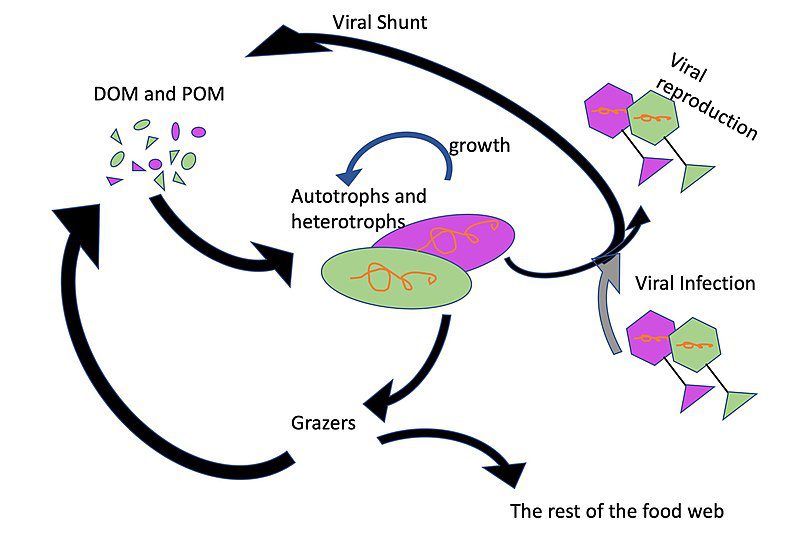The sea has always been considered a great biological buffer, together with Phytoplankton, bacterial and viral populations with the microbial loop and the viral shunt, relentlessly resist the phenomena of ocean acidification and global warming.
In this article we will talk about the importance of bacteria and viruses in the transfer of energy between marine ecosystems and their role in biogeochemical cycles.
In all the seas of the world, the microbial community is fundamental. The sea system was classified as a linear food chain, made up of algae, consuming organisms and predators.
In fact, the study of the detrital circuit has changed the view of the functioning of marine ecosystems.
DOM and POM
At each trophic level, two pools in dynamic equilibrium are released into the aquatic environment, the DOM (dissolved organic matter) and the POM (particulate organic matter).
In a cycle of import and export, of organic and inorganic particles, it was discovered that POM is essential for planktonic and benthos organisms, which filter particles and retain nutrients.
Furthermore, in the sea there are many both macroscopic and microscopic organisms specialized in the use of the DOM, especially bacteria.

Biodegradable organic matter is mostly present in the form of macromolecular biopolymers, which cannot be directly taken up by the microbial cell.
Such complex compounds, therefore, must be hydrolyzed by exoenzymes which transform them into simpler monomeric substrates.
The microbial loop
Once taken up by the bacteria, the substrates can be catabolized or breathed or used for the production of bacterial biomass.
The recovery of the organic substance dissolved by bacterial means constitutes the so-called “microbial loop”, which includes, in addition to heterotrophic bacteria, heterotrophic nanoflagellates and ciliates.

The bacteria are able to use the DOM that would otherwise be lost from the food web and transform it into new biomass.
Heterotrophic bacteria therefore play a fundamental role in the marine ecosystem and from simple remineralizers acquire different functions:
- They decompose the DOM and POM;
- becoming a food resource for species in the upper food chain;
- They become competitors of phytoplankton of organic compounds and POMs;
- They pre-digest the refractory organic matter, a resource of POM and nitrogen.
The next step will become the conversion of prokaryotic biomass into other biomass of higher trophic levels.
This step consists of heterotrophic protozoa (mainly nanoflagellates) which regulate the abundance of bacteria according to prey-predator dynamics, and also constitute a food source for organisms belonging to higher trophic levels.
The viral circuit (Viral Shunt)
All organisms can be infected with viruses. A phytoplankton cell or a prokaryotic cell accidentally comes into contact with a virus, the latter adheres to the host’s walls and finally penetrates inside by direct injection of its genetic material or by endocytosis by the host cell.
Therefore, it’s a marine biological mechanism, where viruses exert negative feedback control on the microbial loop.
The discovery of exorbitant viral quantities in certain ecosystems has given way to the study of the role of the microbial loop and the viral shunt, in order to provide a fundamental piece of marine ecosystems.

Therefore, we can summarize the viral shunt as a negative control on phytoplankton and bacterial biomass, a process mediated by viral lysis, which converts biomass into DOM.
The DOM used by bacteria and converted into potentially available biomass at higher trophic levels can be re-transformed into DOM as prokaryotes and other organisms will go into viral lysis. (The microbial loop will take DOM to higher trophic levels, while, the viral shunt returns DOM to the bacteria).

Viral pressure is therefore able to modify the entire circuit, some studies have shown that larger viral populations can reduce the amount of carbon export into the sea through the transformation of living organic matter into particulate or dissolved debris and favor the conversion into carbon. Inorganic dissolved through respiration and photolysis.
Original article “Microbial loop e viral shunt, l’importanza dei microorganismi del mare“ written by Umberto Lazzaro
Translation by Giovanna Spinosa
Sources
- Biologia marina. Biodiversità e funzionamento degli ecosistemi marini. Roberto Danovaro;
- http://www.mna.it/sites/default/files/in_antartide/batterioplancton%20e%20microbial%20loop.pdf;
- Microorganisms in ballast water: Disinfection, community dynamics, and implications for management;
- https://www.researchgate.net/publication/329437609_Microorganisms_in_ballast_water_Disinfection_community_dynamics_and_implications_for_management.
Images credits
- Figure 1: http://www.mna.it/sites/default/files/in_antartide/batterioplancton%20e%20microbial%20loop.pdf;
- Figure 2: https://www.researchgate.net/figure/The-pelagic-food-web-with-the-microbial-loop-as-a-major-path-for-organic-matter-flux_fig3_329437609;
- Image 3: https://www.nature.com/articles/nrmicro1750;
- Image 4: https://en.wikipedia.org/wiki/Viral_shunt.